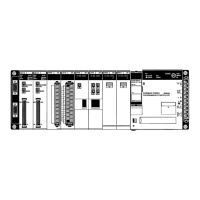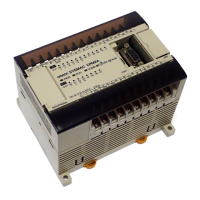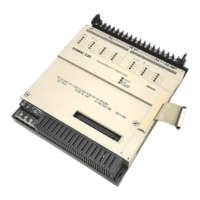!
235
If
bit
14 of C is ON and more than one address contains the same minimum val
-
ue, the position of the lowest of the addresses will be output to D+1.
The
number of words within the range (N) is contained in the 3 rightmost digits of
C, which must be BCD between 001 and 999.
When
bit 15 of C is OFF
, data
within the range is treated as unsigned binary and
when
it is ON the data is treated as signed binary
.
Refer to page
29 for details on
signed binary data.
15 14 13 12 11 00
Data
type
1 (ON):
Signed binary
0 (OFF):
Unsigned binary
Number of words
in range (N)
Not used – set to zero.
Output address to D+1?
1 (ON): Yes.
0 (OFF): No.
C:
Caution If
bit 14 of C is ON, values above #8000 are treated
as negative numbers, so the
results
will dif
fer depending on the specified data type. Be sure that the correct
data type is specified.
Flags ER: Indirectly
addressed
DM word is non-existent. (Content of
:
DM word is
not BCD, or the DM area boundary has been exceeded.)
The number of words specified in C is not BCD (000 to 999).
R
1
and R
1
+N–1 are not in the same data area.
EQ: ON when the minimum value is #0000.
5-21-3 AVERAGE VALUE – AVG(––)
S: Source word
IR, SR, AR, DM, HR, TC, LR
N: Number of cycles
IR, SR, AR, DM, HR, TC, LR, #
Ladder Symbols
Operand Data Areas
D: First destination word
IR, SR, AR, DM, HR, LR
AVG(––)
S
N
D
@AVG(––)
S
N
D
Limitations Data of S must be hexadecimal.
N must be BCD from #0001 to #0064.
D and D+N+1 must be in the same data area.
Description AVG(––) is used to calculate the average value of S over N cycles.
When the execution condition is OFF
, A
VG(––) is not executed.
For
the first
N–1 cycles when the execution condition is ON, A
VG(––) writes the
value
of S to D. Each
time that A
VG(––) is executed, the previous value of S is
stored in words D+2 to D+N+1. The first 2 digits of D+1 are incremented with
each execution and act as a pointer to indicate where the previous value is
stored. Bit 15 of D+1 remains OFF for the first N–1 cycles.
Special Math Instructions Section 5-21

